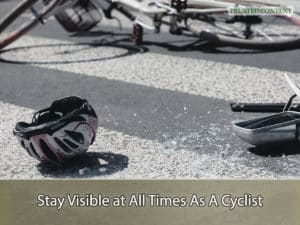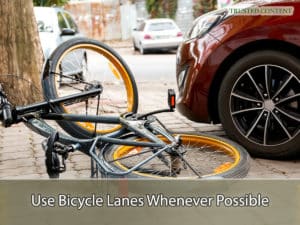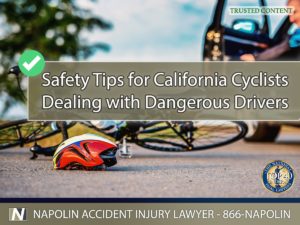Safety Tips for California Cyclists Dealing with Dangerous Drivers
Cycling in California is not just a mode of transportation; it's a lifestyle embraced by many for its health benefits and environmental friendliness. However, the increasing number of cyclists on the road also means a higher risk of encounters with aggressive drivers. California law supports cyclists' rights to share the road, including statutes like the Three Feet for Safety Act, which mandates drivers to keep a minimum distance of three feet when passing a cyclist. This law is a critical component of cyclists' safety, emphasizing the state's commitment to creating a safer environment for biking enthusiasts. Familiarizing yourself with these laws not only enhances your safety but also equips you with the knowledge to advocate for your rights effectively.

Stay Visible at All Times As A Cyclist
Stay Visible at All Times As A Cyclist
Visibility plays a pivotal role in ensuring the safety of cyclists on busy roads. Investing in high-quality reflective gear and installing bright lights on your bicycle are essential steps to make yourself more visible to drivers, especially during dawn, dusk, or nighttime. California Vehicle Code 21201(d) requires bicycles operated during darkness to be equipped with a white light visible from a distance of 300 feet in front and a red reflector visible from a distance of 500 feet to the rear. Additionally, wearing brightly colored clothing during the day can help you stand out. These measures significantly reduce the risk of accidents by ensuring that drivers can see you from a safe distance.
Know the Laws
California's Vehicle Code is comprehensive, covering various aspects of cycling on the road. Besides the Three Feet for Safety Act, cyclists are also protected by laws that allow them to take the full lane when necessary for safety, such as when a bike lane is obstructed or too narrow to share safely with motor vehicles. Cyclists are also subject to the same rules and responsibilities as motorists, including obeying traffic signals and stop signs. Understanding these laws is crucial for navigating the roads safely and confidently. It empowers cyclists to make informed decisions about their positioning and actions on the road, contributing to a safer cycling environment for everyone.

Use Bicycle Lanes Whenever Possible
Use Bicycle Lanes Whenever Possible
Bicycle lanes are specifically designed to offer a safer space for cyclists, separating them from motor vehicle traffic. California has been expanding its network of bike lanes to encourage cycling as a sustainable mode of transportation. When available, using these lanes not only increases your safety but also signals to drivers that you are following the rules of the road. However, when bike lanes are not available, it's important to remember that cyclists have the right to share the road with motor vehicles, taking the full lane when necessary to avoid hazards such as opening car doors, potholes, or debris.
Signal Your Intentions
Effective communication with drivers is key to preventing accidents. This includes signaling your intentions to turn or stop well in advance. California law requires cyclists to use hand signals: extending the left arm out horizontally to signal a left turn, up for a right turn, or down to indicate stopping or decreasing speed. These signals help drivers anticipate your movements and adjust their driving accordingly. Practicing these signals and using them consistently ensures that you convey your intentions clearly, reducing the likelihood of misunderstandings on the road.
Stay Alert and Avoid Distractions
Staying alert and focused is paramount for cyclists, as road conditions and traffic patterns can change rapidly. Distractions, such as using headphones or smartphones while cycling, can significantly impair your ability to react to these changes. California law prohibits the use of earplugs or headsets covering both ears while cycling. Keeping your senses unobstructed allows you to hear approaching vehicles, emergency signals, and other important auditory cues. Additionally, always keep an eye out for aggressive drivers and be prepared to take evasive action if necessary, such as slowing down, changing lanes, or pulling over to avoid a dangerous situation.
Record and Report Aggressive Behavior
Encountering aggressive driving behavior can be a frightening experience for cyclists. If you find yourself in such a situation, it's important to try to record the incident safely, such as by using a helmet cam, and report it to the local authorities. California law takes aggressive driving seriously, and reporting these incidents can help law enforcement address the behavior and potentially prevent future occurrences. Provide as much detail as possible, including the time, location, description of the vehicle and driver, and any witnesses. This information can be crucial for investigations and for improving overall road safety for cyclists.

Safety Tips for California Cyclists Dealing with Dangerous Drivers
Safety Tips for California Cyclists Dealing with Dangerous Drivers
Cycling in California offers numerous benefits and joys, but it also comes with the responsibility of ensuring your safety and the safety of others on the road. By staying visible, knowing and adhering to the laws, communicating effectively with drivers, and staying alert, you can significantly reduce the risk of accidents. However, if you ever find yourself in need of legal assistance due to a road incident, Napolin Accident Injury Lawyer is here to help. With our extensive litigation experience, we are committed to defending the rights of injury victims across California. Injured cyclists can call us at (866)-NAPOLIN for a free consultation, ensuring they receive the support and representation they deserve in navigating the complexities of their cases.
- Safely and Legally Navigating Parking Lots in California - July 15, 2024
- Navigating the Aftermath of a Highway Auto Accident in California - July 15, 2024
- An Overview of California's Commercial Truck Insurance Laws - July 15, 2024
